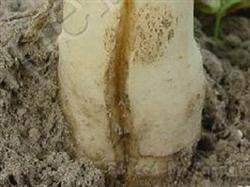How to avoid splitting radishes

1. Soil quality and tillage: the soil ploughing is too shallow and the bottom soil is too hard. At the same time, hard objects such as stones, tree roots, tiles and plastics are not removed in the process of deep ploughing, and the bottom layer of the soil is excellent, which is bound to hinder the main root and promote the occurrence of lateral roots. Once the matter produced by photosynthesis accumulates, the main root and the lateral root hypertrophy at the same time. In addition, the soil is not sunny enough, there are too many pests such as earthworms, grubs and mole crickets, the main roots are damaged, and the lateral roots are produced naturally. There will be bifurcations in the future. 2. The fertilizer is not fully mature: the immature fertilizer contains a lot of uric acid, which not only burns the main root, but also stimulates the lateral root to grow; the application of base fertilizer is uneven and the soil layer is not deep, which also hinders the elongation of the main root to produce lateral roots. once the matter accumulates, the lateral root becomes hypertrophic and bifurcates. 3. The planting density is too large: the distance between seeding and fixing seedlings of radish is too wide, the bifurcation of radish in summer and autumn is less, but there are more bifurcations in autumn, winter or spring, because the weather in autumn, winter and spring is especially beneficial to the growth of radish and the accumulation of photosynthesis is rich. If the planting density is too sparse, the plant growth is particularly exuberant, the leaves produce a lot of photosynthates, and naturally there will be more bifurcations. If the reason for the bifurcation is found, there is naturally a way to avoid it. Conscientiously do a good job of deep ploughing and careful cultivation of the soil and keep the soil loose. Apply fully mature organic fertilizers and spread them evenly into the soil layer. According to the requirements of each variety, reasonable close planting. If we do a good job in these three aspects, the radish bifurcation phenomenon will be overcome naturally.
- Prev

Radish cracking
The cracking is mainly caused by the imbalance of fat between the outer layer and the inner tissue, long drought and rain, and watering in sunny days. In addition, too much nitrogen fertilizer, too much humidity and extensive farming are also easy to crack. Therefore, we should pay attention to the balanced supply of water, avoid sudden watering due to continuous drought, increase the application of potash fertilizer, and strengthen management.
- Next

Boron supplement and air-proof core of radish
The hollow radish affects its edible value and quality, and many vegetable farmers can not find the reason for the hollow radish. In fact, the hollow radish is caused by boron deficiency in the soil. The following methods can be used to prevent hollow radish by applying boron fertilizer: sowing with 300 grams of 17% boric acid or 500 grams of 11% borax per mu.
Related
- Where is it suitable to grow horseradish in China? it is expected to see the middle altitude horseradish in Alishan.
- How to prevent tomato virus disease reasonably? (Control methods included)
- Many people like to plant towel gourd on the balcony. What are the main points of this method and management?
- What crops can chili peppers be mixed with?
- Fertilization techniques and matters needing attention in Tomato
- What are the grafting techniques for peach seedlings in spring?
- Harm and control methods of root swelling disease of Chinese cabbage
- What are the pests of sweet potatoes? How to prevent and cure it?
- Symptoms, causes and Control methods of navel Rot in Tomato
- The cause of "Cucumber rotten bibcock" in Farmers' planting Cucumber and its Control Plan

